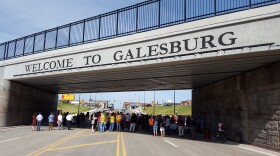When Heather Dickson relocated to Galesburg with her husband and daughter, she had no personal connection to the town. In Hope Cemetery, she began putting streets to names. In the process, she gained a deep appreciation for the free thinkers and innovators that abound in Galesburg's past.
“I’m so surprised that the city hasn’t taken it or it doesn’t get more city recognition because that is our city,” Dickson said. “There it is, right there. All those people who sacrificed to make this city and Knox College happen.”
Dickson, her daughter Paulina, and local historian Rex Cherrington run the Facebook page Friends of Hope Cemetery. The group was originally founded by Cherrington and other members of the Knox County Genealogical Society in the 1980s. At the time, Cherrington was tasked with recording the names and dates on headstones in local cemeteries. When he arrived at Hope Cemetery, the monuments were too overgrown to make out any of the writing.
“The condition of a cemetery like that, in the heart of the city, where your founders are buried, reflects on the community,” Cherrington said. “If it’s in poor condition it reflects badly on the community. Others agreed with that and there was a lot of good volunteerism.”
Today, Friends of Hope Cemetery’s goal is consistent community engagement through its growing social media presence and regular events like tours and spring clean-up days. Founded in March 2017, the Facebook page allows them to reach their audience on a regular basis and not just when the cemetery needs help.

“Rex’ll throw a story on there, Paulina will put a tree that’s fallen down, I’ll put one of a beautiful day,” Dickson said. “It keeps it relevant all the time, which I think it’s a great way of keeping people interested in it.”
Knox College Assistant Professor of Anthropology-Sociology Jonah Rubin, whose research focuses on interactions between living communities and their dead, stumbled on Friends of Hope Cemetery through Facebook. Rubin has been bringing his sociology classes to Friends of Hope Cemetery’s annual spring cleanup days ever since. He sees it as one of the few spaces where Galesburg and Knox come together.
“It’s one of those spaces where people come together not just to interact with each other but to engage in a collective project of building a better community, of paying tribute to those who created both of our communities and really work at imagining a future together as college and town,” Rubin said.

According to Heather Dickson, the Facebook page saw a huge increase in membership last fall. The group began scheduling more tours to accommodate rising interest. Dickson hopes people show the same enthusiasm for their volunteer events. Since Hope Cemetery is private (meaning it does not receive tax money from the city), it relies almost entirely on donations and volunteer labor for upkeep. The Hope Cemetery Association cares for the grounds but Cherrington said monuments are technically the responsibility of the families that buy them.
“Many of these families have no one in the community anymore and if they’re somewhere in the country we don’t know how to contact them, they don’t come here and show any interest in it,” Cherrington said. “So, that responsibility tends to fall on volunteers from the community.”
One of Friends of Hope Cemetery’s first projects was to raise the funds to buy a monument for Susan Richardson, a woman who escaped slavery and ran a business in Galesburg for many years. Until the 1980s, her grave was unmarked. Rubin explained how this represented a shift in the way Galesburg saw itself as a community. The city’s decision to memorialize Richardson indicates a reimagining of race relations past, present, and future.
“Her story kind of fell by the wayside until the 1980s, when people really wanted to revive that story as a central part of our identity as Galesburg and as Knox,” Rubin said. “Part of that was telling that story through the installation of this physical, material marker that we can go to and see and touch and interact with.”
Most American cemeteries were and are racially segregated due to Jim Crow Laws or social and religious divides. Hope Cemetery has been integrated since it was created by Galesburg’s abolitionist founders. Besides Susan Richardson, the cemetery holds the remains of members of the second African-American Civil War regiment, the 54th Battalion.
In tending the graveyard, the members of Friends of Hope Cemetery have come to care for it as a living thing. Heather Dickson is always happy to see flowers on the nine graves of unknown U.S. soldiers. Cherrington explained that during the Civil War, bodies were sometimes sent back to the wrong families. Without standard embalming, the best thing people could do was give the soldier a proper burial and government-issue monument. Dickson sees the flowers as evidence that the soldiers have become part of a collective family.
“People are looking after them,” she said.





